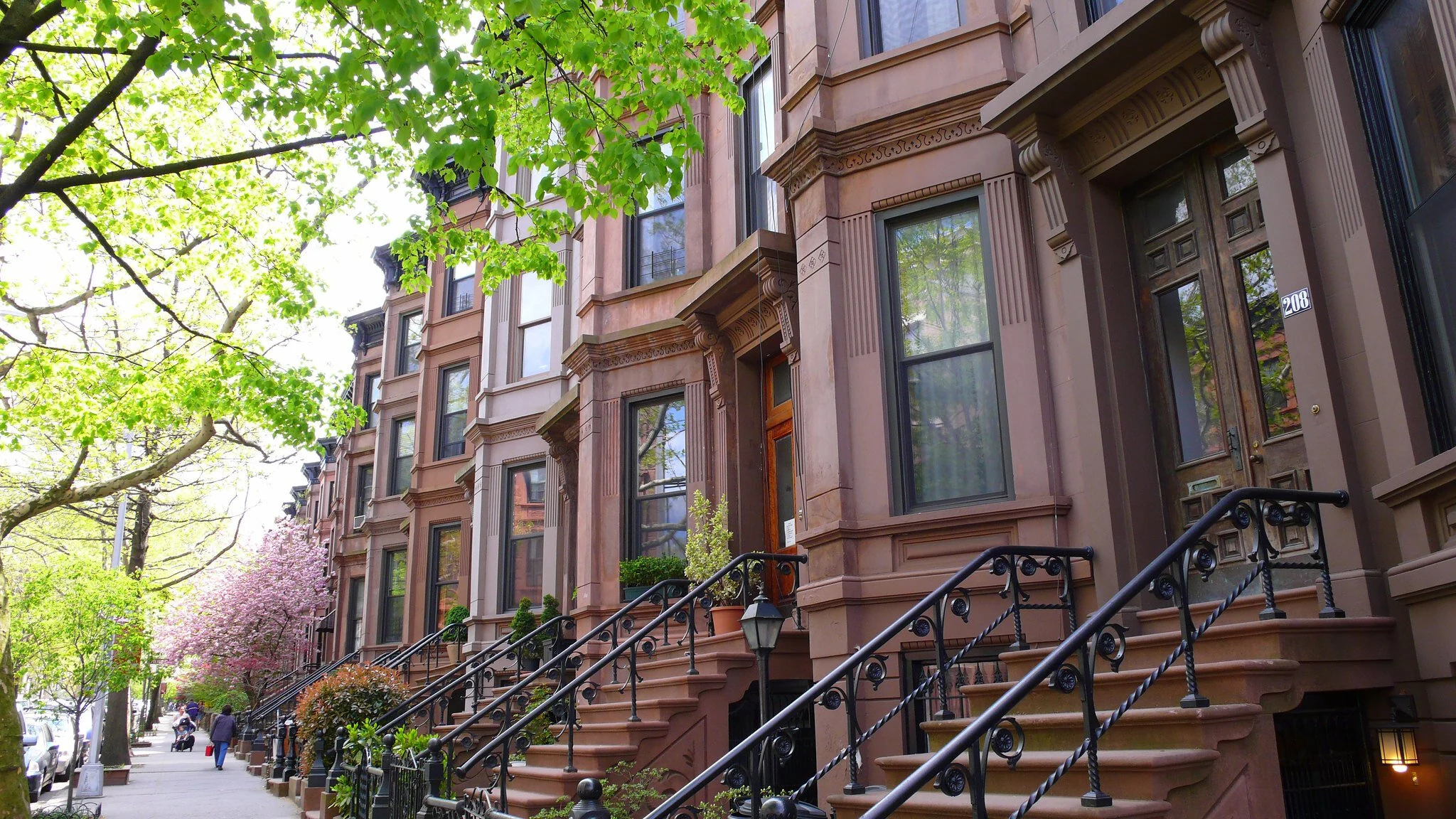affordable housing
The Towns Outsmarting Airbnb
Late last year, New York City made headlines when it all but banned Airbnbs and other short-term rentals within city limits. Since the pandemic, Airbnb had overtaken an estimated 39,000 rental units, hollowing out neighborhoods and causing already-high rents to grow even higher.
“You would see tourists on the streets in neighborhoods where there weren’t any hotels,” recalls New York-based artist and activist Murray Cox. The sound of rolling suitcases could be heard at all hours. Once tight-knit communities began to feel lifeless. When Cox ran the numbers on his own neighborhood — Bed-Stuy in Brooklyn — he found about 1,000 listings. Cox also heard horror stories from other parts of the city. “People would move into a building and then find that the building was full of tourists day in and day out,” he says. “In some cases, they would be so uncomfortable they’d feel forced to leave.”
 New York City’s crackdown on Airbnbs is part of a growing trend. Credit: Matthew Rutledge / Flickr
New York City’s crackdown on Airbnbs is part of a growing trend. Credit: Matthew Rutledge / Flickr
So, in September of 2023, New York City decided to do something about it. A series of bold requirements capped the total number of short-term rentals (STRs) and limited guests to just two at a time. They required STR operators to be primary homeowners — and to be present in the home while hosting. The city also promised to enforce those requirements, a move that would wipe out nearly 90 percent of active listings at the time.
Though it may sound revolutionary, New York’s crackdown isn’t the first of its kind. In fact, it’s part of a growing trend — one largely spearheaded by much smaller towns. Over the last decade, communities from Irvine, California, to Durango, Colorado, have implemented clever regulations, taxes and zoning policies to hobble the STR market — or, in some cases, eliminate it altogether. As the success stories pile up, a growing body of research points to the dramatic positive impacts of policies like these, including lower rents, more equitable housing markets and the promise of a sustainable tourism economy.
When Airbnb was founded more than a decade ago, it was heralded as the harbinger of a new sharing economy. In theory, home-sharing platforms — including Airbnb, Couchsurfing, VRBO, FlipKey and Homestay — would put underutilized bedrooms to use, matching budget-conscious travelers with locals in need of a little extra cash. The system would funnel tourism dollars into small towns in a more equitable way. It seemed like a win-win. But within a few years, one clear loser emerged: communities.
“It didn’t take very long for people to realize the sharing economy was basically a scam,” explains Cox, who later went on to found data-sharing platform Inside Airbnb. “People weren’t using that car that was sitting in the driveway to drive Uber. And people weren’t just renting out a sofa or a spare bedroom.” Instead, people saw an economic opportunity they could invest in. And they started buying whole homes to rent out on Airbnb.
In many cases, speculators and investment companies were buying multiple homes expressly for short-term rental use. According to Cox, about two-thirds of Airbnb rentals in the US are in a property portfolio, which means the host owns and rents more than one property. And the top one percent of operators have more than 300,000 Airbnb listings among them — a stat that points to huge conglomerates gobbling up the market.
 In September of 2023, New York City enacted bold requirements that capped the total number of short-term rentals and limited guests to just two at a time. Credit: RightFramePhotoVideo / Shutterstock
In September of 2023, New York City enacted bold requirements that capped the total number of short-term rentals and limited guests to just two at a time. Credit: RightFramePhotoVideo / Shutterstock
These days, Airbnb isn’t just a way to share underutilized bedrooms; it’s big business.
Right now, about 90 percent of Airbnbs in Bozeman, Montana, and Nashville, Tennessee — both popular vacation spots — are whole homes. Both Bozeman and Nashville are also relatively small towns with exploding local populations and limited housing stock. That means that every home set aside for a year-round STR listing is a home unavailable to local residents struggling to find — and afford — housing. In extreme cases, the STR explosion has forced longtime locals to move away. The so-called “Airbnb Effect” can hollow out once-vibrant communities.
This effect is most visible in popular vacation hot spots. In Hawaii, for example, out-of-towners have bought up so many homes that few are left for Native Hawaiians.
Crushed by negative news?
Sign up for the Reasons to be Cheerful newsletter.
[contact-form-7]
“On Maui alone, 52 percent of homes are sold to nonresidents, and 60 percent of condos and apartments have gone to investors and second homeowners,” writes Stanford researcher Noah Jordan Magbual in a recent report. “The once indigenous population of the Hawaiian archipelago are now outcasts in their own home.”
The Airbnb Effect also impacts bigger urban areas. In 2015, one study found that STRs had sucked at least 10 percent of New York’s available housing off the market. Another New York study showed that this reduction in supply led to rent increases of up to hundreds of dollars per year. In Barcelona, the effect is even more severe, with rents rising by seven percent and housing costs rising by up to 17 percent in popular neighborhoods.
For some cities, the proliferation of STRs has become more than just an economic issue; it’s existential. That’s especially true in New Orleans, the longtime home of Jeffrey Goodman, an urban planner and consultant who specializes in STRs.
Credit: Mr. Nixter
Tourists are drawn to New Orleans for culture: art, food, music and more. But the city is becoming less and less affordable for the people who make those things possible.
“We were one of the earlier cities to experience the growth in short-term rentals,” Goodman says. “And we’re in a unique place because so much of what we sell is culture. It’s art. It’s food. But the people who make the art and cook the food and play the trumpets have a hard time living here.” So, if the locals who make New Orleans special are forced to move away, what’s left?
“There are a lot of cities asking themselves this question,” says Goodman. “Are we a city anymore or are we just Disneyland?”
According to Goodman, the Airbnb Effect is stronger in small communities, like mountain towns or beach towns, which tend to have limited housing stock, high home prices and little flexibility to adapt to fluctuations in housing availability. That may be why small towns were among the first to fight back.
In 2014, Durango — a town of 20,000 in southwestern Colorado — passed a series of regulations to combat what one local newspaper called “The Airbnb Apocalypse.” The town, an adventure epicenter for mountain bikers, climbers, skiers and other outdoor sports enthusiasts, isn’t just a tourist magnet. It’s also home to Fort Lewis College, a premiere university for Native American students and Colorado locals. That was an experience Durango was anxious to protect.
Durango’s 2014 regulations banned STRs outright in student neighborhoods. They also limited STRs to two percent of the housing stock elsewhere.
 Tourists ride the Durango & Silverton Narrow Gauge Railroad along the Animas River. Credit: Woody Hibbard / Flickr
Tourists ride the Durango & Silverton Narrow Gauge Railroad along the Animas River. Credit: Woody Hibbard / Flickr
“In doing this, the city made it clear that preserving student housing took precedence over any money they were going to get from tourism,” says Goodman.
Today, city planning officials say the program has been a huge success.
“Durango led the way in creating effective guardrails to protect the community from being overrun with STRs,” says Scott Shine, director of Durango’s Community Development Department. Today, he says, STRs make up just 1.4 percent of the city’s total housing stock. They just aren’t really an issue anymore.
A year later, Santa Monica — an affluent California beach town of 90,000 — passed its own ordinances, banning STRs offering stays of less than 30 days for an entire home. The city also extended its 14-percent hotel tax to STR operators and made it illegal to operate them without a valid business license. According to one estimate, the ordinance has since dropped the city’s number of Airbnb listings by 61 percent, potentially returning more than 1,000 homes to the long-term rental or purchasing markets.
Many of these novel STR policies look great on paper, but the truth is that they’re hard to enforce. Few cities have spent more time thinking about this issue than San Francisco.
San Francisco-based housing activist Dale Carlson first heard about the Airbnb Effect back in 2014, when the city was undergoing a major housing affordability crisis. When he learned that nearly five percent of the city’s limited housing stock was devoted to Airbnbs, he decided to get involved.
Carlson helped bring together a coalition of tenants, hotels and property rights groups. By 2015, they’d successfully lobbied for a city ordinance that required hosts to register their STRs, have a business license and pay hotel taxes. But it wasn’t enough.
Credit: Dale Cruse / Flickr
Cities across American watched as San Francisco enacted its platform-accountability policies. Now, some of those cities have enacted policies of their own.
“We still ended up with 15,000 or 16,000 listings,” Carlson says. So, his group asked voters to get behind an entirely new concept: the principle of platform accountability.
“The idea is that [the rental platform] can list and or rent anything it wants, but it can only collect a booking fee on the stuff that’s legal,” Carlson explains. If passed, the ballot measure would put the onus on Airbnb — not the city — to police unregistered and therefore illegal listings. Airbnb fought the initiative, and it fought hard.
“We were defeated in the ballot. Airbnb spent close to $10 million—they outspent us 20 to 1,” Carlson says. But despite the heavy spending, Airbnb barely eked out the win. “So many people had told us, ‘You’re never going to beat them because they’re too big and powerful,’” Carlson says. “But suddenly they didn’t look so powerful. And we didn’t seem so vulnerable.”


Become a sustaining member today!
Join the Reasons to be Cheerful community by supporting our nonprofit publication and giving what you can.
Carlson’s coalition reworked the initiative and tried again. The next time, the ballot measure passed. Within a few months, Carlson says, Airbnb listings in the city had dropped by about 90 percent. Cities across America were watching. Others, like Boston and New York, ultimately adopted platform-accountability policies of their own.
Another important aspect of San Francisco’s policy is that hosts can only use their primary residences as STRs. According to Carlson, that’s dramatically limited speculative purchasing.
“All the folks who were buying up units or renting units and then subletting them on Airbnb — that’s all gone,” he says.
A few years later, Irvine, California, enacted an even more severe policy — with more dramatic results. In 2018, the city banned all short-term rentals under 30 days and hired a fintech firm to track down and report scofflaw hosts. This ban more than halved the number of Airbnb properties. Eight years on, rents in the city have dropped by up to three percent, according to a recent study. That saves tenants about $114 per month on average.
 The city of Irvine banned all short-term rentals under 30 days, cutting the number of Airbnb properties down by more than half. Credit: Matt Gush / Shutterstock
The city of Irvine banned all short-term rentals under 30 days, cutting the number of Airbnb properties down by more than half. Credit: Matt Gush / Shutterstock
Choosing the right STR regulations can be very location-dependent, says Goodman, the city planning consultant. Some towns might need a combination of ordinances, while complete bans might work better in others. But according to Michael Seiler, the College of William and Mary researcher who led the Irvine study, we now have strong evidence that limiting STRs can indeed reduce rents. And, he says, it’s likely that Irvine’s solution could be successfully applied in other towns.
“If I was another policy maker in a sister city, I would say let’s at least try it,” he says. “Because we’ve shown that it does work here.”
New York hasn’t been the only city to act in recent years. In 2023, Bozeman passed regulations forcing STR platforms to ask for operators’ permit numbers. The policy makes it difficult for bad actors to list their homes illegally, and makes it easy for the city to double-check that listings are appropriately registered and legally operating. Bozeman also mandated that STRs be primary residences — not second homes purchased as rental properties.
There may also be some market solutions around the corner. A cadre of startups are taking up Airbnb’s original mission and reworking it into a more holistic, community-friendly approach. New platforms like Trusted Housesitters and ReFlat are making it easier to find mutually beneficial housing swaps, while millennials are bringing time-shares back into vogue in Colorado ski towns.
In the future, these regulatory and entrepreneurial solutions could work together to give travelers affordable lodging options — without sacrificing the needs of local communities.
“A lot of people will say Airbnb is here to stay, but New York City shows you that’s not necessarily the case. When they decided to enforce their housing laws, it was really effective,” says Cox. “New York City’s approach is a good model to show that we can be as restrictive as we want. It’s up to us.”
The post The Towns Outsmarting Airbnb appeared first on Reasons to be Cheerful.
What If Finding Affordable Housing Worked More Like Matchmaking?
Dozens of framed photographs and paintings on the walls in Gabrielle’s cozy one-bedroom apartment in Boyle Heights showcase her artistry and cherished memories from trips to New Zealand and Europe. Her favorite is a black and white portrait of a miner in New Zealand panning for gold.
Gabrielle (who is comfortable printing only her first name) feels she struck gold, too, when she moved into this light-filled apartment in September 2019. She calls the place — with an open kitchen, a large bathroom and a sweeping view over park greenery and palm trees to the snow-capped mountains outside of Los Angeles — her “safe haven,” after feeling unsafe for several years.
A professional gemologist whose family once had five jewelry stores in Hawaii, she had struggled with alcoholism and mental health issues, and a suicide attempt left her in a coma for five days. While she was recovering from major neck surgery and fighting to be granted disability, she was living in her car in Los Angeles for several months and in transitional housing for more than 15 months. She wondered if she would ever have an apartment again or “be stuck in a hell hole forever.”
 A 2020 report found that Los Angeles had more than one vacant residential unit for every unhoused person. Credit: Ocean Image Photography / Shutterstock
A 2020 report found that Los Angeles had more than one vacant residential unit for every unhoused person. Credit: Ocean Image Photography / Shutterstock
Gabrielle’s luck began to change when a California nonprofit called Brilliant Corners got involved. She had qualified for help from the Los Angeles County Department of Health Services Housing for Health division that gives priority to vulnerable clients with health issues. (Gabrielle contributes 30 percent of her income to the rent, and the rest is covered by the program’s subsidy.) But when the Boyle Heights apartment in a former hospital opened up, the landlord didn’t want to rent to her because of her bad credit. The real estate specialists at Brilliant Corners worked with Gabrielle’s case manager at the local nonprofit Life Steps to convince the landlord he was not taking a big risk in accepting Gabrielle as a renter.
Brilliant Corners was founded in 2004 by several nonprofit service providers with the mission to find housing for people with intellectual and developmental disabilities in three California counties. In 2014, it significantly expanded its mission to extremely low-income Californians and began operating the Flexible Housing Subsidy Pool, in partnership with the Los Angeles County Department of Health Services and private partners such as the Conrad N. Hilton Foundation, as part of the Housing for Health initiative. The Flex Pool is a supportive housing rent subsidy program that helps match vulnerable individuals with available housing options.
Crushed by negative news?
Sign up for the Reasons to be Cheerful newsletter.
[contact-form-7]
The key is its flexibility: “For one landlord, it was a dealbreaker that the applicant had $3,000 in debt. So we paid off half the debt,” says Kolby Vaughn, Brilliant Corners’ associate housing services director in San Diego, which has a Flex Pool that is funded by the Regional Task Force on Homelessness. “For another client, cooking was really important so we spoke with the landlord [to see] if we could put a hot plate in his unit. These are the kind of hurdles we can overcome outside of the bureaucratic process.”
With a budget of over $200 million, braiding state, local and private funding sources, Brilliant Corners has been able to make a significant impact. “We have developed the capacity to administer over $10 million of rent subsidies every month,” according to Brilliant Corners CEO Bill Pickel. To date, the nonprofit has placed nearly 13,000 unhoused people into permanent homes in Los Angeles, averaging about 200 people a month. Brilliant Corners contracts with government agencies, such as the L.A. County Department of Health Services or Veterans Affairs, other nonprofits and community partners, and pairs up with Intensive Case Management Services to help clients achieve and maintain health and housing stability.
Its initial efforts in L.A. focused on the most vulnerable clients who frequently used costly emergency services. This is how Brilliant Corners makes the case that it actually saves the county money. According to a 2017 Rand study that analyzed the first two and a half years of the program, every $1 invested in the program saved the county $1.20 in health care and other social service costs. The idea is that once clients have stable housing, they have a better foundation to address other issues including their physical and mental health.
 Brilliant Corners housing coordinator Adriana Flores helped Brian Wearren get over housing hurdles. Credit: Morgan Soloski
Brilliant Corners housing coordinator Adriana Flores helped Brian Wearren get over housing hurdles. Credit: Morgan Soloski
“Clients are typically referred by a government agency or a local case management nonprofit,” Pickel explains, as was the case with Life Steps, the local nonprofit that helped Gabrielle. “We meet individuals one on one.” BC’s housing coordinators provide support from the initial contact all the way through. “They are sticking with one person and don’t leave them alone once they are in an apartment,” says Pickel. “Most folks need some level of ongoing support.”
NPR calls Brilliant Corners a “real estate agency for the unhoused,” because what distinguishes it from other housing programs is its dedicated team of landlord engagement specialists who build long-standing relationships with landlords so they know when a unit will become available. This strategy is considerably different from the normal bureaucratic process where overworked case managers need to find the time to canvas neighborhoods and rental portals for available apartments.
“Especially in California communities where the real estate market is so intense and vacancies are so limited, landlords have lots of choices and might go with someone who just landed a job at Google or Facebook,” Pickel notes. “How can low-income folks possibly compete in such a competitive market to secure a unit? We help put everything in place to match somebody with the unit.” Brilliant Corners sometimes enters into long-term agreements with landlords; these could include guaranteeing rent from day one even before the tenant moves in and assurances that rent is paid on time.
Manola Rodriguez, for instance, who owns and manages 50 apartment units in Antelope Valley with her husband, met Brilliant Corners representatives when they were canvassing the neighborhood in 2014. She has been renting half of her units to Brilliant Corners clients ever since. “We believe in second chances,” she says. “It’s very hard for people to function without a roof over their head.”
Despite its convincing model, Brilliant Corners has dozens of one-star reviews on online platforms where both clients and landlords complain that they have been unable to reach anybody at the nonprofit when problems arose, such as a rodent infestation or behavioral issues with mentally ill renters. But Rodriguez says that Brilliant Corners representatives were always there to assist with problems.
 Brilliant Corners client Brian Wearren enjoys his apartment building’s rooftop. Courtesy of Brilliant Corners
Brilliant Corners client Brian Wearren enjoys his apartment building’s rooftop. Courtesy of Brilliant Corners
To cut through even more red tape and avoid cumbersome bureaucracy, Brilliant Corners is currently developing five multifamily housing sites in L.A., totaling 376 units of permanent supportive housing. The nonprofit is also managing its own residential care homes.
The situation is particularly dire in Los Angeles County, which counted more than 75,500 unhoused people in 2023, an uptick of nine percent from 2022. The homeless number in the city has gone up 10 percent to 46,260, and more than 2,000 unhoused people died last year in the city amidst the housing and fentanyl crises, more than six deaths a day. The alarming death rate, too, rises significantly every year.
A Harvard study shows that low-rent units under $1,400 a month have disappeared fast across all states, particularly in California. “We’re rehousing people faster and more people. Even though the number of people we are able to house is rising, the number of people who need affordable housing is rising faster,” Pickel admits. “What comes to mind is the unfortunate image of bailing water out of a boat, but there’s more water coming in than we can bail out.”
On her first day in office in December 2022, L.A. Mayor Karen Bass signed an emergency declaration on homelessness, promising to cut red tape and fast-track affordable housing permits. Activists laud her efforts, but they are far from enough. “Billions are being spent. What are we doing wrong?” Pickel asks. “I think we have a multi-generational complex social problem that includes the failure to build enough housing at various income levels, including middle-income housing, workforce housing and deeply affordable housing. We also have a tragically fractured social safety net and an unfolding crisis of people in severe distress, whether it’s from mental health, substance abuse or so many other reasons. It is really hard to develop our way out of this problem. We would need something in the order of $10 to $12 billion a year. That’s a staggering number.”
Similarly, in San Diego, Kolby Vaughn says that more people end up unhoused for the first time than Brilliant Corners and other services can put in apartments. Many seniors are aging into homelessness because their pensions are not keeping up with housing prices. Since launching the San Diego Flex Pool in October 2020, Brilliant Corners has housed 900 individuals and families in need, with a focus on youth, veterans and those with complex health issues. But the need continues to mount: California needs 1.4 million more affordable rental units.
At the same time, studies also show that a significant percentage of high-rent housing is lying vacant, held for its value not as shelter, but for investment purposes. A 2020 report found that Los Angeles had more than one vacant residential unit for every unhoused person.


Become a sustaining member today!
Join the Reasons to be Cheerful community by supporting our nonprofit publication and giving what you can.
This is where Brilliant Corners sees a lever to offer landlords incentives to rent to their clients by giving them assurances other nonprofits can’t. “We’re not building our way out of homelessness,” Brilliant Corners housing coordinator Adriana Flores says. She has experienced housing insecurity herself. “A lot of us have been in our clients’ shoes,” she says, and she calls what she offers them “a hand up, not a handout.”
Her client Brian Wearren is a success story. After being honorably discharged from the Navy and then having been incarcerated for 25 years for assault and robbery, Wearren faced some hurdles to finding housing: He had no rental history, no credit and no income. But he found himself a one-bedroom apartment in San Diego on the 12th floor with a view over the city. Brilliant Corners helped him pay for application fees and furniture, and Flores assured the landlord the rent was guaranteed with his VA (Veterans Affairs) rent voucher. Now he works two jobs as a plumber and a fiber optics cable installer and wants to pay it forward.
“I’m extremely lucky and had a lot of support, but not everybody is so lucky,” Wearren says. “I want to establish transitional housing for guys like me who come out of the military or out of incarceration.”
The post What If Finding Affordable Housing Worked More Like Matchmaking? appeared first on Reasons to be Cheerful.
The 3D-Printed Affordable Housing of the Future Will Be Recyclable
When you imagine a 3D-printed home, you probably picture a boxy concrete structure. As 3D printing’s popularity has grown in the construction industry — thanks to its efficiency when it comes to time, energy and cost — carbon-intensive concrete has become the go-to building material.
But a project in Maine has set its sights on something different: a neighborhood of 600-square-foot, 3D-printed, bio-based houses crafted from materials like wood fibers and bioresins. The aim: a complex of 100-percent recyclable buildings that will provide homes to those experiencing houselessness.
In late 2022, an initiative between the University of Maine and local nonprofit Penquis unveiled its prototype — BioHome3D, the first 100-percent recyclable house. Now, the pioneering project is working toward completing its first livable housing complex. It will be fully bio-based, meaning all materials will be derived from living organisms such as plants and other renewable agricultural, marine and forestry materials.
 Once the pilot project is completed and the team reaches full commercial capacity, the team will be able to print a home in as little as two days. Courtesy of the University of Maine ASCC
Once the pilot project is completed and the team reaches full commercial capacity, the team will be able to print a home in as little as two days. Courtesy of the University of Maine ASCC
As the materials are all 100-percent recyclable, so become the buildings. The materials are also all renewable. And thanks to its natural composition, the home acts as a carbon sink, sequestering 46 tons of carbon dioxide per 600-square-foot unit.
The materials for this project will mainly come from wood left over by local mills. “The wood fiber material that’s used in the mix is essentially waste wood here in Maine,” says Jason Bird, director of housing development for Penquis. Bird is referring to what’s known as wood residuals: materials that, he explains, “pulp mills or other sawmills either landfill, discard or set off to the side and rot.”
Courtesy of University of Maine ASCC
Houses like BioHome3D could be built anywhere in the world that bio-based materials are available.
According to the University of Maine, the state’s sawmills produce nearly one million tons of wood residuals every year. Since each 600-square-foot unit requires approximately 10 tons of wood residuals, 100,000 housing units could theoretically be produced every year using just sawmill residuals.
Crushed by negative news?
Sign up for the Reasons to be Cheerful newsletter.
[contact-form-7]
The University of Maine’s Advanced Structures and Composites Center received $3.3 million in funding for this project last year, and its collaboration with Penquis has set out to build a ready-to-live neighborhood with nine 3D-printed homes for people experiencing houselessness. As the team undergoes the final regulatory hurdles, Bird anticipates that houses could be ready to live in as early as this spring.
 “The wood fiber material that’s used in the mix is essentially waste wood here in Maine,” says Jason Bird. Courtesy of the University of Maine ASCC
“The wood fiber material that’s used in the mix is essentially waste wood here in Maine,” says Jason Bird. Courtesy of the University of Maine ASCC
Once this pilot project is completed and the team at the University of Maine reaches full commercial capacity, Bird says the team will be able to print a home in as little as two days.
“That would include the shell of the house — the roof, walls, floors system,” Bird explains. “Long-term [infrastructure projects] could include cabinets, countertops, bath fixtures. And what gets me so excited about this project is that the technology isn’t just solving a local problem, it could be replicated around the world.”
Dr. Habib Dagher, executive director of the Advanced Structures and Composites Center, confirms that the technology is intended to be widely replicated.
“The goal of this research is to create a system for constructing homes that alleviates strains on the supply chain and addresses labor shortages, while providing economical and sustainable housing,” says Dr. Dagher. “This technology can be used anywhere in the world that has access to bio-based raw materials. We are focused on scaling up production technology to drive down costs and increase availability.”
And after enduring a year of extreme weather in Maine, with sensors reporting temperatures ranging from 1 degree to 105 degrees Fahrenheit, BioHome3D met all sustainability, strength, and durability requirements for US building codes, as well as the design requirements of the International Code Council code.
“Doing this project in a place like Maine, which has some of the most extreme temperatures in the continental US, is vital because it can prove that this material can endure huge temperature swings,” says Sarah Goehrke, founder of Additive Integrity, a consulting service that focuses on the examination and sustainable acceleration of industrial 3D printing. “The fact that BioHome3D survived for a year is very important proof going forward.”
Courtesy of the University of Maine ASCC
The BioHome3D prototype was printed on the world's largest 3D polymer printer at the University of Maine's Advanced Structures and Composites Center.
Initial printing speeds of 20 pounds per hour have since ramped up to nearly 500 pounds per hour, significantly reducing construction costs. This efficiency, combined with local materials, makes the process more sustainable and resilient to global supply chain disruptions.
The project is a timely response to an already pressing and worsening global housing crisis. UN-Habitat predicts that by 2030, three billion people will require improved housing. And with traditional construction contributing a staggering 27 percent of global greenhouse emissions, less-polluting alternatives will need to rise to the occasion. In Maine, the need is clear: the state is already experiencing a shortage of 20,000 affordable housing units.
“What’s more innovative about this project [than other 3D housing initiatives] is both that it’s bio-based, and that it’s geared fully toward addressing the housing crisis,” says Goerhke.


Become a sustaining member today!
Join the Reasons to be Cheerful community by supporting our nonprofit publication and giving what you can.
3D-printed houses produce significantly less waste than conventional construction, as builders are able to print exactly the amount of material they need for a given project, and minimal space is needed for storage materials. And with the ability to store all materials in the same space, the energy otherwise required to transport materials between sites is eradicated.
One forecast projects that the global 3D construction market will soar by 91 percent from 2021 to 2028.
“Building many smaller structures in a short amount of time is what the housing crisis needs to address unhoused people and help to create larger communities quite quickly,” says Goerhke.
The post The 3D-Printed Affordable Housing of the Future Will Be Recyclable appeared first on Reasons to be Cheerful.
Helping Councils improve key worker housing affordability

Housing affordability is a common topic of conversation across Australia. Taking the case study of Regional Victoria, Nenad takes a look at how rising housing costs impacts an area’s ability to attract and house key workers for that region.
Key worker housing affordability analysis →
Key worker housing affordability: A national problem
Australia’s key workers, that is, workers in services that are essential to a community’s functioning and wellbeing, spend large proportions of their household income on housing costs. The “Priced Out” report, published by Everybody’s Home in April 2023 found key workers on average spending two-thirds of their income on housing as increasing rental costs price them out of their communities.
Workers in aged care, hospitality, freight packing and postal services were among those most impacted, and the report also found there were very few regions in Australia where essential workers could afford to rent alone, while those in coupled homes were probably financially dependent on their partner’s income.
Key worker housing affordability: Regional Victoria case study
Housing affordability is worsening in Regional Victoria, driven by increased demand, shifts in employment dynamics (e.g. working from home/remote work) and COVID-19. Migration from Greater Capital Cities to regions has contributed to increased housing costs, which have raised median house prices to near-Greater Melbourne levels in some parts of Regional Victoria.
Almost 55,000 people living in Regional Victoria in 2021 lived somewhere within Greater Melbourne a year before. In fact, 43% of all people who moved to Regional Victoria from Greater Melbourne in the 2016–2021 period did so in the one year before the 2021 Census.
In December 2023, Regional Development Victoria created the “Regional Worker Accommodation Fund”, a program that allows many entities, including regional local governments, to apply for grants between $150,000 and $5,000,000 for the provision of new housing and accommodation for regional communities where workers in key industries and their families are struggling to find places to live. Further information on eligible projects, funding and the application and outcome process are outlined in the Program Guidelines and frequently asked questions.
Who are key workers?
Key workers are vital to a community’s wellbeing. Although there are no standard definitions of “key worker” occupations, key workers are generally employees in services that are essential to a municipality’s functioning, whose role requires them to be physically present at a work site rather than working from home. Key worker occupations include but are not limited to: waiters, chefs, kitchen staff, commercial cleaners, police, enrolled and mothercraft nurses, doctors, truck drivers, motor mechanics, electricians, welfare support workers and checkout operators.
What is the challenge?
Median house prices in Regional Victoria have increased by 153% since June 2019 and median rental costs by 128%. Both have flattened off in recent months with no indication of significant decline, while other costs of living have also increased, likely resulting in higher levels of housing stress for regional key workers and other Regional Victorian residents.
Keeping key workers close to their place of work is best for the economy and the social fabric of a community but can be a challenge in regional areas, particularly those with high tourism. Housing unaffordability pushes key workers to look for housing further away from their place of work, places of social interaction, support networks, schooling, etc. This can impact a region’s ability to attract or maintain key workers in roles necessary for places to operate and thrive.

What is the role of council?
Local government authorities can take several measures to address housing unaffordability for key workers in their municipality – from challenging long-held assumptions about higher-density developments within local planning considerations (in some cases), to collaborating with State Governments and discussing releasing additional land or engaging constructively in zoning conversations. Councils can also:
- Establish affordable housing as essential infrastructure: Following the recommendation by parliamentary committees, local governments can lead the way in recognising affordable housing as essential infrastructure, prioritising it within their overall infrastructure plans (“Building Up & Moving Out”, 2018).
- Coordinate and collaborate: Local governments should actively engage with State and Federal authorities to develop comprehensive strategies to tackle the affordable housing crisis (ALGA, 2023).
- Explore key worker housing programs: Consider implementing key worker housing affordability programs. Strategies for this can be developed by studying reports and recommendations on declining housing affordability over the years (“Key Worker Access to Home Ownership”, 2018).
- Support national initiatives: Local governments should actively support and participate in national initiatives aimed at improving housing affordability, such as the National Housing and Homelessness Plan (“Developing the National Housing and Homelessness Plan“, 2023).
We encourage councils to get their policies on affordable or key worker housing in order and seek support, partnerships, and grants to address the situation.
How we can help
We’ve worked with several Victorian councils, including the City of Melbourne, to help quantify and understand housing affordability for key workers. The main findings in all previously completed projects were that key workers are vital to a municipality and that some occupations are under much higher housing stress than others, yet housing is becoming less affordable to purchase or rent for most key worker housing groups.
We can support councils looking to obtain funding in various ways:
- Sharing how councils can use their existing suite of .id tools to develop business cases.
- Subscribing to housing.id to build strategies and monitor the ongoing housing situation, including affordability trends.
- Undertaking consulting, such as our Key Worker Housing Affordability report, to quantify key workers in your region, articulate their importance to the local economy and understand whether housing is appropriate and affordable for different key worker groups.
Please contact us for this or any other support.